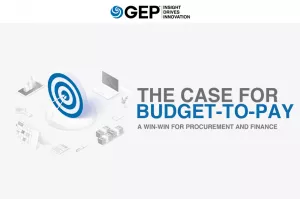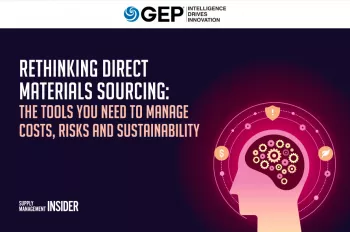It’s a tough time to be a CFO right now. The looming recession — catalyzed by the COVID-19 pandemic — can stifle enterprise growth for the next few quarters and beyond.
Which means, CFOs need all the cash they can save internally to sustain and enable growth — and a new, more effective approach to reduce costs: Budget to Pay (B2P).
In a timely new paper, The Case for Budget to Pay: A Win-Win for Procurement and Finance, GEP discusses a new approach to help CFOs achieve rapid cost reduction and save cash.
What’s Inside:
- The difference between Budget to Pay and Source-to-Pay
- How B2P can help achieve greater cost reduction and savings
- The role of procurement in B2P
- How finance and procurement can collaborate to implement B2P
It’s a must-read for finance and procurement leaders looking for effective ways to improve cash flow and take out significant costs from business spend — get your complimentary copy today.
It’s a tough time to be a CFO today. The looming recession has been accelerated by a global pandemic that has brought everything to a grinding halt. Most industries are going to see the top line decline by more than 30% in Q2 2020; if the pandemic lasts longer, Q3 will see a similar decline.
Some sectors, such as retail and hospitality, have been hit more severely; in the United States, most of these companies are furloughing more than 70% of their workforce.
While CFOs are not experiencing this pandemic any differently than others in the organization, they are the ones tasked with navigating the corporate survival ship. Government stimulus packages will ease the pain a bit; however, unlike 2008, the “bounce” is not going to come merely from quantitative easing. Organizations must generate cash from their own operations after years of investment for growth.
Over the past decade, CPOs have worked diligently to squeeze money out of indirect expenses, resulting in an ability to directly contribute to the bottom line while elevating the role of procurement through strategic sourcing, standardization, and source-to-pay programs. Procurement has increasingly adopted source-to-pay (S2P), a unified approach to maximizing value and productivity within the procurement process. An evolution of procure-to-pay (P2P), the operational efficiency gains of S2P are proven: cost reductions of 30-40%, reduced maverick spending, more effective sourcing, better contract management, better supplier relationship management, and more.1
But there’s been a further evolution of the unified procurement strategy: budget to pay (B2P). It is the next frontier as organizations continue to push for more EBIT savings, more visibility, and more control.
Organizations embark on numerous cost reduction initiatives, spending millions of dollars on external expertise and driving multiple transformation initiatives, only to realize later that the impact on the P&L is minimal. Ensuring traceability back to the books is a huge challenge faced by CFOs, and primarily attributed to poor understanding of enterprise data and misaligned incentives for leadership teams.
We believe that to tackle these challenges, there is a common denominator — the ability to more accurately and responsively set and manage indirect budgets, which leads to unparalleled visibility and control.
The traditional partnership between finance and procurement should evolve beyond just implementing an assortment of siloed process optimization programs. The end-to-end spectrum, from budgeting all the way through invoicing and payment, needs to be properly linked. B2P does just that — it’s the answer to the urgent need to cut costs dramatically.
B2P gives CFOs the ability to meet these seven key challenges:
1. There is no “one system of record” for indirect expenses — unlike direct expenses, where you have an ERP to track commodity pricing, consumption, inventory, and budgets
2. Cost allocation and controllability of primary costs not strictly followed — it’s usually only set for secondary costs
3. Limited working knowledge of cost centers and general ledger accounts — managers don’t necessarily know where to book costs
4. “No P.O., No Pay” not strictly enforced — enterprise funds are being committed without appropriate approvals
5. Absence of “Right First Time” checks — this leads to inaccurate P.O.s, “financial journaling”, and re-postings, making original budgets hard to trace, and future budgets hard to forecast
6. Lack of supplier integration — P.O., travel, and staffing tools are integrated with supplier platforms but not with financial cost center structures, leading to ineffective control
7. Inflexibility to change budgets — difficult to divert costs from poor-performing areas to growth areas because data transparency is lacking
Simply put, B2P enables finance to gain better control, establish a more proactive, fluid budgeting process, maintain higher visibility of data across finance systems and business processes, and help ensure greater accuracy between budgets, P.O.s and payables. It takes the next step beyond S2P to help procurement jointly develop cost control measures with finance as opposed to simply collaborating on the impact of an organization’s P&L cost reductions.
WHAT IS B2P AND HOW DOES IT WORK?
B2P is a framework that enables finance and procurement to jointly drive cost reduction initiatives right from the budgeting process all the way until invoices are matched and paid.
During the annual budget-setting process, procurement works closely with finance to establish control towers that set targets for each budget control area. The prevailing rule: No Budget, No P.O. – No P.O., No Pay.
Once annual cost reduction targets are aligned, every purchase request is tracked against a specified budget for that control tower. If the control tower is out of budget, it gets locked and no further purchase requests can be approved until additional funds are made available.
Accountability is easier and more accurate because all data is consolidated in one place. Procurement reports on any savings directly from finance reporting systems, not on a separate savings tracker. And of course, if there are any savings against budgets, the finance leadership can then decide how and when to reinvest the additional funds.
HOW B2P FILLS THE GAPS IN BEST-IN-CLASS PRACTICES
| Current Best Practice | Gaps | How B2P Helps |
| Controls Limited mostly to P.O. buying channel |
Non-P.O. buying channels such as travel & expenses or temporary staffing get a blanket budget cut | Intervention for budget cuts should be surgical and blanket “cost bans” can be avoided |
| Static Process Budgets tied to A/P data, with no real-time data integration of indirect costs |
No flexibility to change with business needs, and fewer opportunities for behavioral change | All budget data elements integrated into one view, tracked by purchase requisition |
| Visibility Limited to about 60% of budget consumption value |
No single source of truth on status of budget consumption | Every budget dollar can be tied to actuals, open P.O.s, non-P.O. provisions or approved purchase requisitions |
| Accuracy Only 40% correct based on P.O. spend at best |
No strong incentive to get P.O. right the first time, with excessive time spent correcting metadata to fix cost allocations | Budgets checked at purchase requisition provide incentive to improve accuracy before funds are formally committed |
HOW IS B2P DIFFERENT FROM S2P?
In an S2P value chain, all decisions are driven by the availability of budgets — it’s governed by the No Budget, No Pay principle. In B2P, however, controls are set up in the procure-to-order process, where budget checks are added to existing controls such as contract compliance.
Prior to every sourcing event in a B2P implementation, procurement and finance look for budget availability, thus reducing unproductive sourcing initiatives. To help ensure accuracy, P.O. metadata such as general ledger accounts, cost center, supplier and pricing information are ratified prior to release. Given the possibility of a lockout due to overspending, this forces the organization to book costs correctly upfront.
At the end of each reporting period, consumption is updated for actuals, accruals, and open P.O. amounts, and the tracker is reset for the next period. Budgets are then checked automatically, enabling the organization to close obsolete P.O.s so that funds can be made available for business-critical initiatives.
CASE STUDY: B2P REDUCES SPEND BY 30%, 10% Y-O-Y OVER 3 YEARS FOR A MANUFACTURER
A leading European manufacturer sought to strategically manage its SG&A spend. It embarked upon a program of procurement transformation including a B2P solution, and implemented it globally in North America, greater China, Central and Eastern Europe, Asia-Pacific, and Latin America.
With a unified procurement platform as its system of record, the company established 35 spend control towers to streamline cost allocations and establish a categorization methodology and integration of buying channels across P.O.s, travel, temporary staffing and purchasing cards for tracking.
The spend control towers provided demand management capabilities, including a demand challenge program, which enabled finance and procurement to query every requisition to ensure budget compliance. This in turn enabled a comprehensive financial budget review capability and business prioritization capability.
The result: budget reductions across the entire SG&A — a 10% year-over-year indirect spend reduction, and a 3% year-over-year reduction in demand challenges.
WHAT MAKES A SUCCESSFUL B2P IMPLEMENTATION?
More visibility... greater control… more access to much-needed funds for critical business initiatives. The benefits of implementing a B2P solution are immediately tangible for procurement and for finance. But to help ensure a successful implementation, there are a number of questions to ask yourself:
1. “Are we ready for change?”
B2P is not just another tool; it offers a complete transformation from the top down that demands behavioral change throughout the organization. Don’t underestimate the level of change management required. However, it’s important to note that your organization can opt to implement a B2P solution incrementally.
2. “Can we invest the time?”
There’s no point in automating a broken process. Take the time up front to clearly define the allocation process, finance hierarchy, and accrual policies.
3. “Are we ready to work together?”
B2P is a great catalyst for elevating the role of procurement and improving relationships with business units, functions and regions throughout your organization.
When you have found clear answers to these three key questions, you will be better positioned to take definitive steps toward implementing B2P within your organization, further strengthening the strategic relationship between procurement and finance.
1 SOURCE: GEP ANALYSIS
Theme: Procurement



